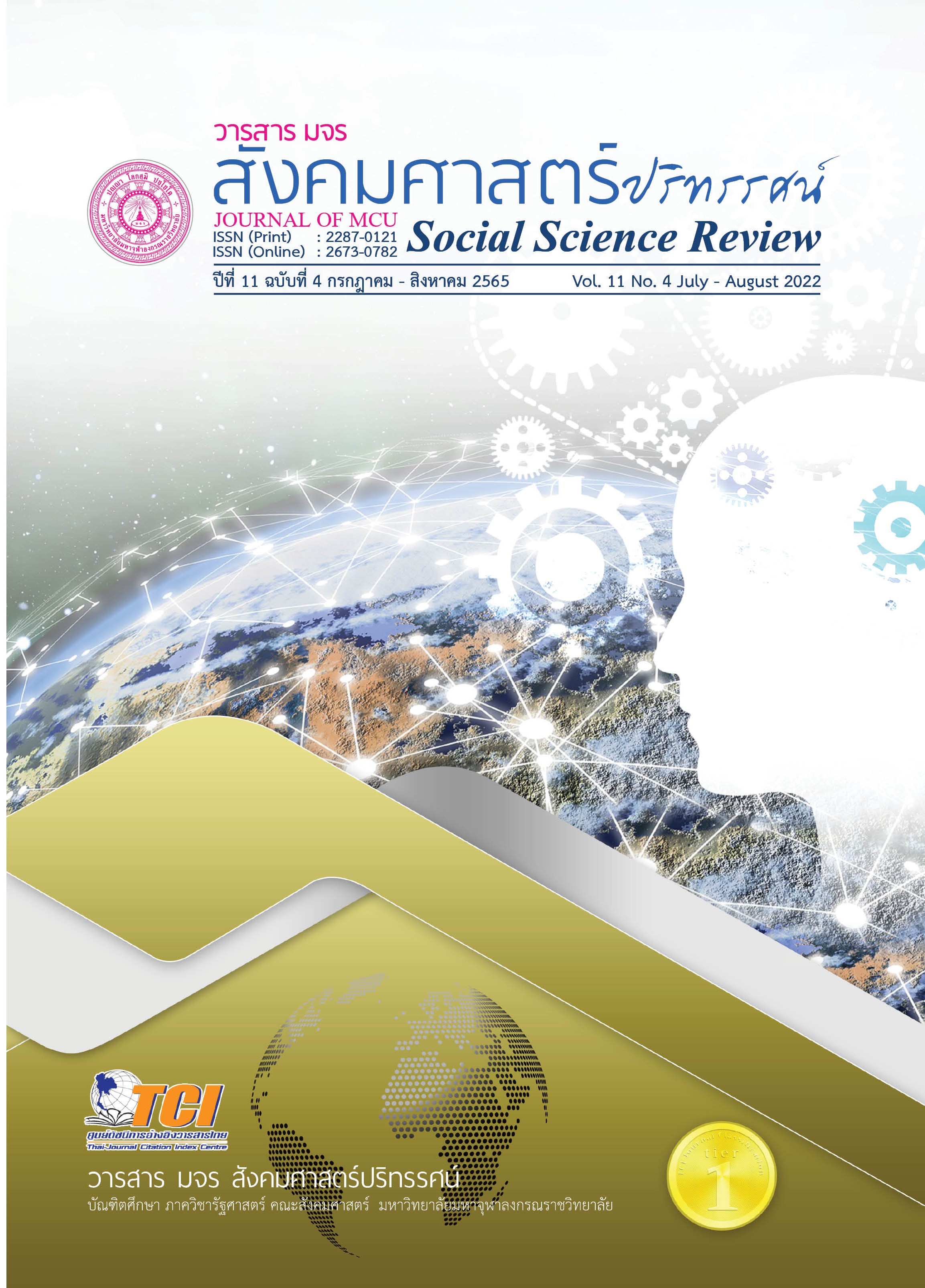บุญกู่ : คติความเชื่อและพลวัตพิธีกรรมการบูชากู่บ้านเมย อำเภอหนองสองห้อง จังหวัดขอนแก่น
คำสำคัญ:
คติความเชื่อ, พลวัตพิธีกรรม, กู่บ้านเมยบทคัดย่อ
บทความวิจัยนี้เป็นวิจัยเชิงคุณภาพเพื่อศึกษาคติความเชื่อและพลวัตพิธีกรรมในพื้นที่กู่บ้านเมย อำเภอหนองสองห้อง จังหวัดขอนแก่น โดยใช้การสัมภาษณ์แบบเชิงลึกจากประชากรในชุมชนบ้านเมยประกอบกับเอกสารและงานวิจัยที่เกี่ยวข้อง รวมถึงโบราณสถานและโบราณวัตถุ ในการวิเคราะห์ข้อมูล
จากการศึกษาพบว่า กู่บ้านเมย อำเภอหนองสองห้อง จังหวัดขอนแก่น อดีตถูกสร้างขึ้นเพื่อประกอบพิธีกรรมตามความเชื่อทางศาสนาในสมัยพระเจ้าสุริยวรมันที่ 1 ผู้วิจัยจึงมีการวิเคราะห์พลวัตการเปลี่ยนแปลงของพิธีกรรมแบ่งออกเป็น 2 ประเด็น ได้แก่ ประเด็นประวัติศาสตร์ร่วมสมัย โดยมีการตั้งข้อสังเกตใหม่เกี่ยวกับศาสนาในการสร้างกู่บ้านเมยไว้ว่ามีการพลวัตที่เกิดจากอิทธิพลการปกครองของกษัตริย์ คือสร้างขึ้นด้วยความเชื่อทางศาสนาพราหมณ์แล้วจึงพลวัตเป็นศาสนาพุทธ และประเด็นประวัติศาสตร์ท้องถิ่น ช่วงเวลาประกอบด้วย 1.ช่วงเริ่มก่อตั้งหมู่บ้านบ้านเมย 2. ช่วงการมีบทบาทของหน่วยงานภาครัฐกับกู่บ้านเมย 3. ช่วงภายหลังการสำรวจและบูรณะกู่บ้านเมย ช่วงเวลาดังกล่าวแสดงให้เห็นการเปลี่ยนแปลงทางด้านรูปแบบ องค์ประกอบของพิธีกรรม ขั้นตอนของพิธีกรรม รวมถึงผู้เข้าร่วมในพิธีกรรมอย่างชัดเจน โดยชุมชนได้มีการปรับรูปแบบพิธีกรรมให้เข้ากับบริบทสังคมตามยุคสมัยแต่ยังคงคติความเชื่อเดิมเรียกขานว่า “บุญกู่”
เอกสารอ้างอิง
กมลเมศวร์ ภัตตาจารย์. (2504). ศาสนาพราหมณ์ในอาณาจักรขอม [Les Religions Brahmaniques dans I’ Ancien Cambodge d’ apres I’ Epigraphie et I’ Iconographie] (สุภัทรดิศ ดิศกุล,ม.จ.,แปล). กรุงเทพฯ: โรงพิมพ์พิฆเณศ.
กวินวัฒน์ หิรัญบูรณะ. (2563). ร่องรอยศาสนาพราหมณ์-ฮินดูและพระพุทธศาสนาในพื้นที่จังหวัดศรีสะเกษสมัยก่อนพุทธศตวรรษที่ 23. วารสารมนุษย์ศาสตร์และสังคมศาสตร์ มหาวิทยาลัยราชพฤกษ์, 5(3), 1-13.
กรมศิลปากร. (2529). จารึกในประเทศไทยเล่ม 1 อักษรปัลลวะ พุทธศตวรรษที่ 12-14. กรุงเทพฯ: หอสมุดแห่งชาติ กรมศิลปากร.
ปฐม หงส์สุวรรณ. (2556). ประเพณีประดิษฐ์ในชุมชนอีสานลุ่มน้ำโขง. (รายงานวิจัย). กรุงเทพฯ: สำนักงานกองทุนสนับสนุนวิจัย.
แป จงเทพ. (2564, 28 กันยายน). [บทสัมภาษณ์].
ผาสุก อินทราวุธ. (2522). รูปเคารพในศาสนาฮินดู. กรุงเทพฯ: ภาควิชาโบราณคดี คณะโบราณคดี มหาวิทยาลัยศิลปากร.
พิกุล สมัครไทย. (2544). การอนุรักษ์และพัฒนาโบราณสถานกู่บ้านเมย หมู่ 8 ตำบลหนองสองห้อง อำเภอหนองสองห้อง จังหวัดขอนแก่น. ขอนแก่น: สำนักศิลปากรที่ 9 ขอนแก่น กรมศิลปากร กระทรวงวัฒนธรรม.
รวีโรจน์ จงเทพ. (2564, 26 สิงหาคม). ผู้ใหญ่บ้าน. [บทสัมภาษณ์].
รุ่งโรจน์ ภิรมย์อนุกูล. (2546). ข้อคิดเห็นใหม่เกี่ยวกับศาสนาของพระเจ้าสูรยวรรมันที่ 1. วารสารเมืองโบราณ, 29(1), 10-21.
วิมล เขตตะ และคณะ. (2560). กัมรเตง อัญ: ศึกษาในประเด็นที่มาและรูปแบบการใช้คำ. วารสารช่อพะยอม, 28(1), 11-20.
ศิราพร ณ ถลาง. (2552). ทฤษฎีคติชนสร้างสรรค์บทสังเคราะห์และทฤษฎี. (พิมพ์ครั้งที่ 2). กรุงเทพฯ: ศูนย์มานุษยวิทยาสิรินธร (องค์การมหาชน).
เสาวลักษณ์ อนันตศาสนต์. (2552). ทฤษฎีคติชนวิทยาและวิธีการศึกษา. กรุงเทพฯ: มหาวิทยาลัยรามคำแหง.
ไสว ทองดี. (2564, 25 สิงหาคม). [บทสัมภาษณ์].
อำไพ คำโท. (2529). “ศิลาจารึกนางขาว”. ในจารึกประเทศไทยเล่ม 4 : อักษรขอม พุทธศตวรรษที่ 17-18. กรุงเทพฯ: หอสมุดแห่งชาติ กรมศิลปากร.
อุดม ทาไธสง. (2564, 27 สิงหาคม). [บทสัมภาษณ์].
Coedés, G. (1964). Les états hindouisés d'Indochine et d'Indonésie. Paris: Edition E. de Boccaed.
Ida Bagoes Mantra. (1991). “The Cult of Siva-Buddha,” in The Art and Culture of South-East Asia. Edited by Lokesh Chandra. New Delhi: International Academy of Indian Culture and Aditya Prakahan.
ดาวน์โหลด
เผยแพร่แล้ว
รูปแบบการอ้างอิง
ฉบับ
ประเภทบทความ
สัญญาอนุญาต
ลิขสิทธิ์ (c) 2022 วารสาร มจร สังคมศาสตร์ปริทรรศน์

อนุญาตภายใต้เงื่อนไข Creative Commons Attribution-NonCommercial-NoDerivatives 4.0 International License.
เพื่อให้เป็นไปตามกฎหมายลิขสิทธิ์ ผู้นิพนธ์ทุกท่านต้องลงลายมือชื่อในแบบฟอร์มใบมอบลิขสิทธิ์บทความให้แก่วารสารฯ พร้อมกับบทความต้นฉบับที่ได้แก้ไขครั้งสุดท้าย นอกจากนี้ ผู้นิพนธ์ทุกท่านต้องยืนยันว่าบทความต้นฉบับที่ส่งมาตีพิมพ์นั้น ได้ส่งมาตีพิมพ์เฉพาะในวารสาร มจร สังคมศาสตร์ปริทรรศน์ เพียงแห่งเดียวเท่านั้น หากมีการใช้ภาพหรือตารางหรือเนื้อหาอื่นๆ ของผู้นิพนธ์อื่นที่ปรากฏในสิ่งตีพิมพ์อื่นมาแล้ว ผู้นิพนธ์ต้องขออนุญาตเจ้าของลิขสิทธิ์ก่อน พร้อมทั้งแสดงหนังสือที่ได้รับการยินยอมต่อบรรณาธิการ ก่อนที่บทความจะได้รับการตีพิมพ์ หากไม่เป็นไปตามข้อกำหนดเบื้องต้น ทางวารสารจะถอดบทความของท่านออกโดยไม่มีข้อยกเว้นใดๆ ทั้งสิ้น





